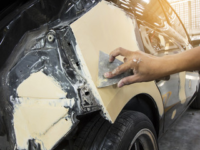How Auto Paint Restoration Works


Your car’s paint may look dull and drab compared to when it rolled off the dealership lot. Fortunately, this is a common problem that can be corrected.
Maintaining a routine cleaning schedule and addressing damage promptly can protect your vehicle’s paint coat from further deterioration. Protective coatings and waxes can also help shield the paint from contaminants that cause oxidation and corrosion.
When a car is brand new, it gleams with unmatched beauty. The smooth paint, the flawless dashboard, and that sweet smell of newness—it’s enough to make you smile just thinking about it. Unfortunately, the joy of driving a new car quickly turns to dismay as scratches, scuffs, and fading eat away at the shiny factory paint.
Thankfully, there are ways to slow the deterioration of your vehicle’s paint and even restore it to a nearly new condition. One of the most important steps is to thoroughly clean the surface and remove any contaminants that may have accumulated. This can be accomplished by a simple car wash or with the use of an effective clay bar.
While it’s possible to do this at home with the right products, it’s generally a good idea to leave this step to professional car detailers. They have the experience and knowledge to know how deep each scratch, scuff, and blemish goes so that they can use the right tools and abrasives to restore your car’s appearance.
The first thing a professional will do is wash your car, making sure to completely remove all of the contaminants that have clung to the surface. It’s not always enough to simply wash a car, as contaminants like airborne pollutants, soot, tar, rail dust, and paint overspray can often penetrate the clear coat and down to the base metal of your vehicle. These contaminants can cause the metal to rust, which will eventually damage the finish of your paint job.
This process is a crucial part of the restoration process, as it allows the professional to see how much of the old paint can be saved and helps them determine which areas require repainting. It also creates a microscopic cross pattern on the surface that will help your new paint adhere better later in the process.
After washing the body, many professional car detailers will then apply several coats of primer and filler to the surface. This layer of paint is designed to fill in a multitude of imperfections left behind by well-sanded skim coats of bodywork and seal the metal against moisture, protecting it from oxidation and future damage.
Remove layers of old paint.
If your car has had multiple paint jobs over the years or shows signs of rust, it may need to have its old layers of paint stripped. Removing paint can be laborious and time-consuming, but it is essential to the success of any repainting project. There are a number of different methods that can be used to remove the old paint, including sanding, media blasting, scraping, and chemical stripping. There are many debates about which of these methods is best, but the fact is that all must be completed in order to have a good surface to paint over.
For a large job, you may want to hire a professional. However, if you have plenty of space and the proper equipment, you can also do this work at home. Be sure to wear the appropriate safety gear, such as a dust mask and gloves. You should also be working in a well-ventilated area, and a sheet should be placed underneath the vehicle to catch any falling debris.
A good-quality sanding block and sandpaper are ideal tools for this task. Begin with the grit that is recommended on the package and work your way up to the finer sandpaper. Be sure to wipe down the car between each sanding session. This is to ensure that you are removing any accumulated dust and dirt that could cause damage to the new coat of paint.
There are several good chemical strippers on the market that are intended for automotive use and can be purchased at most auto parts stores. If you choose to use a chemical stripper, be sure to read the instructions carefully and cover any areas that you don’t want the chemicals to touch. Be sure to wear protective clothing, including a dust mask, rubber gloves, and goggles.
Once the old paint has been removed, it must be completely neutralized before the new surface can be painted. This is done by spraying the area with a product that dissolves the acidic residue. It is important to be sure that all surfaces of the body are completely neutralized, as even small amounts of the stripping solution can damage a new paint job over time.
Apply the new paint.
After all of the sanding and cleaning are complete, it’s time to apply the new paint. This step is when the auto paint restoration process really begins to come together. It starts with a base coat, which will provide protection from contaminants that can damage the vehicle’s clearcoat. Next, a primer will be applied to the bare surface to prepare it for a final coat of paint. The primer will help the color last longer by creating a microscopic cross pattern that helps the car’s finish hold on to it better.
A clear coat is then applied to the top of the primer to seal in the new color. This coat will give the vehicle a high-gloss shine that will make it look brand new. It will also protect the base coat from UV rays, which are the leading cause of faded car paint.
The clear coat can actually stop the oxidation process by reflecting some of the sun’s harmful rays, which gives the vehicle owner more time to drive it in a less sunny area. The car’s owner can also prevent oxidation by regularly washing their vehicle with a quality wax and polish that will provide the best protection against the elements.
Another major factor in a vehicle’s paint fading is the type of paint that was originally applied. Single-stage paints have a much greater chance of fading than vehicles painted with a separate base coat and clear coat. This is because the clear coat is what helps block out the UV rays that can damage the car’s finish.
Lastly, pollution is a huge contributing factor to a car’s paint deteriorating. The acid rain that is produced in many cities can eat away at the paint, leaving the vehicle vulnerable to corrosion. This is why it’s important to wash your car on a regular basis, especially when living in a large city.
The car repair experts at AutomotiveTouchup are here to help you with all of your car restoration needs. Our team of experienced professionals can restore your faded car paint to like-new condition with our professional auto body repair services. We offer both in-shop and mobile services to meet the needs of any customer. You can contact us today to get started on your car restoration project!
Buff the surface
Before applying the new paint, you should buff the surface. Buffing removes any remaining scratches and helps the paint look smooth. To do this, you will need a buffer and some polish. Buffing can be done by hand or with a machine. The collision repair program at UTI uses snap-on electric buffers, but you can also find battery-powered or air-powered ones. Make sure the buffer you choose is appropriate for your vehicle’s finish. If you have a matte or satin finish, you will need a less aggressive polish and pad. If you have a clear coat, you can use a more aggressive one.
After you have completed the buffing process, your car will look great. You can then apply a protective coating or wax to protect the paint from future damage. A high-quality automotive paint protection product can help your restored car last for years to come.
As the sun beats down on your car, it can cause the clear coat to deteriorate. This can lead to oxidation and the dull and faded paint appearance you see on so many cars. While oxidation can be hard to fix, there are ways to restore the luster of your vehicle’s paint without needing costly repainting at an auto body shop.
The best way to prevent future oxidation is to maintain regular cleaning routines. Start by washing your vehicle regularly with automotive-specific soap and water. Rinse the car thoroughly after each wash, then dry it with a clean cloth. In between washes, consider using a quick detailer or detailing spray to remove any dirt, grime, or bird droppings.
Another important step in maintaining your repaired or repainted car is to inspect it regularly. Check for rock chips, scratches, or fading. If you notice any, it is important to touch them up or repair them as soon as possible. If you let these issues go too long, they will continue to eat away at the paint, eventually leaving you with a damaged or unattractive finish.
While it is possible to do a DIY auto paint restoration project, this task is better left to professionals. Professionals have the right tools, knowledge, and experience to ensure your restored vehicle looks amazing.






